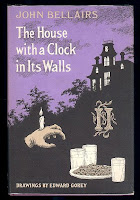 Published in 1973 by The Fantod Press, Edward Gorey's last installment of Three Books from Fantod Press once again gives us three individual books published concurrently and issued in a printed envelope. All three titles are limited to 500 unnumbered, unsigned copies and this time they are housed in a printed white envelope. There is also a special signed limited edition of 26 A-Z lettered copies which were issued in a special beige printed envelope. The books I am showing are from the edition of 500 copies and each book has been signed by Mr. Gorey. All three titles from this publication appear in Amphigorey Too.
Published in 1973 by The Fantod Press, Edward Gorey's last installment of Three Books from Fantod Press once again gives us three individual books published concurrently and issued in a printed envelope. All three titles are limited to 500 unnumbered, unsigned copies and this time they are housed in a printed white envelope. There is also a special signed limited edition of 26 A-Z lettered copies which were issued in a special beige printed envelope. The books I am showing are from the edition of 500 copies and each book has been signed by Mr. Gorey. All three titles from this publication appear in Amphigorey Too. Miss Squill, the main character in The Disrespectful Summons is accosted by, and dances with the Devil. This exchange changes her life in ways she was not predestined to follow. This is my favorite of the three books presented here, and the volume has some wonderfully evil situations (and laugh out loud illustrations) which arise from Miss Squill's evil tendencies after her encounter with the Devil. Of course, one cannot be taken by the Devil without ending in the Flaming Pit, but at least Miss Squill seems to have enjoyed her wickedness, even if it was thrust upon her.
Miss Squill, the main character in The Disrespectful Summons is accosted by, and dances with the Devil. This exchange changes her life in ways she was not predestined to follow. This is my favorite of the three books presented here, and the volume has some wonderfully evil situations (and laugh out loud illustrations) which arise from Miss Squill's evil tendencies after her encounter with the Devil. Of course, one cannot be taken by the Devil without ending in the Flaming Pit, but at least Miss Squill seems to have enjoyed her wickedness, even if it was thrust upon her. In The Abandoned Sock, Mr. Gorey once again gives life to an inanimate object. The sock is not so much abandoned, but rather finds that life in the wide world is not all that it had imagined it to be after it makes an unwise decision to remove itself from its mate. I have always felt the title of this volume to be misleading, since the sock itself makes the choice to leave.
In The Abandoned Sock, Mr. Gorey once again gives life to an inanimate object. The sock is not so much abandoned, but rather finds that life in the wide world is not all that it had imagined it to be after it makes an unwise decision to remove itself from its mate. I have always felt the title of this volume to be misleading, since the sock itself makes the choice to leave. The Lost Lions, or, Having Opened the Wrong Envelope is a meandering tale of a hardy young man whose life is thrust in strange directions, beginning when he opens the mail one day and decides to follow the path set forth by the missive found therein. This leads to fame, a mental breakdown, and loss of purpose in his life.
The Lost Lions, or, Having Opened the Wrong Envelope is a meandering tale of a hardy young man whose life is thrust in strange directions, beginning when he opens the mail one day and decides to follow the path set forth by the missive found therein. This leads to fame, a mental breakdown, and loss of purpose in his life.All three books in this set revolve around a life altering choice. In The Disrespectful Summons, the choice is made by an outside force (the Devil). In The Abandoned Sock the sock leaves it mate, and the downward spiral begins. The protagonist of The Lost Lions chooses to follow a proposition set forth in a piece of mail, and from that day forward, finds that his life has lost focus. Being published as a set, these three volumes magnify how choices can adversely affect a whole lifetime.




















